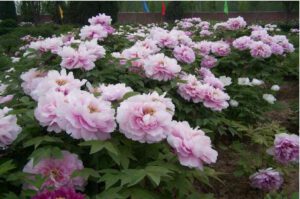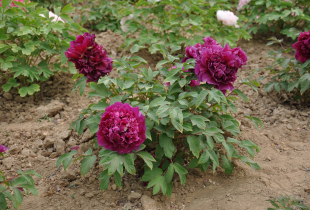Peony is a rare and precious woody flower in China, known as "The beauty of Heaven" , "the King of flowers" laudatory name, has long been regarded as a symbol of prosperity and prosperity
Morphological characteristics
The root system of tree peony is fleshy and strong, little branch and fibrous root. Plant Height 1-3m, up to 2M, old stem gray-brown, yellow-brown branches of the same year. Leaves ternate-pinnate, alternate. Single stem tip, 10-30 cm in diameter, White, yellow, pink, red, purple and multi-color, single, double, double and platform-shaped flowers. There are five sepals.
When peonies bloom
When peony blooms, can set shed cover or temporarily put indoors, avoid direct sunlight, such can lengthen Florescence, to main branch terminal bud is bud, should pick, lest be long, affect to blossom. In order to make peony bloom brightly, 0.5%-1% dihydrogen phosphate solution could be sprayed on leaves 2-3 times. After the peony flower withers, must carry on one time shaping pruning, cuts the remnant flower and the pedicel in time, does not make the seed, retains the stem 1-2 lateral buds, this may cause the plant to grow exuberantly, guarantees the next year flowering.
Peony watering is unfavorable much, winter does not water commonly. After may the weather gradually hot, if the day dry land, may moderate watering, but should be dry should not wet, soil dry before watering. During showers and plum rains, water should be prevented to prevent damage to the plants. Storms or continuous rain often harden the soil. When the ground dries after a rain, you must hold on to the loose soil. Soil aeration can be improved by loosening the soil in time. Peony root system into the soil vertically, loose soil should be deep. Loose topsoil at least 3 times a year, once after spring flowering, once after summer Meiyu season and once after autumn typhoon and rainstorm.
Peony's characteristics are "four appropriate fear" , that is, should be cold fear of freezing, should be warm fear of heat, should be light fear of shade, should be dry fear of wet. Therefore, planting peony to choose spacious ventilation, morning sunshine, fertile soil loose place, can not be planted in water, wet land, rubble land. When building a platform to plant, the size of the platform should be based on the number and size of plants, height should be based on the original topography and the height of the ground water level. General Height is 50-100 cm
Morphological characteristics
The root system of tree peony is fleshy and strong, little branch and fibrous root. Plant Height 1-3m, up to 2M, old stem gray-brown, yellow-brown branches of the same year. Leaves ternate-pinnate, alternate. Single stem tip, 10-30 cm in diameter, White, yellow, pink, red, purple and multi-color, single, double, double and platform-shaped flowers. There are five sepals.
When peonies bloom
When peony blooms, can set shed cover or temporarily put indoors, avoid direct sunlight, such can lengthen Florescence, to main branch terminal bud is bud, should pick, lest be long, affect to blossom. In order to make peony bloom brightly, 0.5%-1% dihydrogen phosphate solution could be sprayed on leaves 2-3 times. After the peony flower withers, must carry on one time shaping pruning, cuts the remnant flower and the pedicel in time, does not make the seed, retains the stem 1-2 lateral buds, this may cause the plant to grow exuberantly, guarantees the next year flowering.
Peony watering is unfavorable much, winter does not water commonly. After may the weather gradually hot, if the day dry land, may moderate watering, but should be dry should not wet, soil dry before watering. During showers and plum rains, water should be prevented to prevent damage to the plants. Storms or continuous rain often harden the soil. When the ground dries after a rain, you must hold on to the loose soil. Soil aeration can be improved by loosening the soil in time. Peony root system into the soil vertically, loose soil should be deep. Loose topsoil at least 3 times a year, once after spring flowering, once after summer Meiyu season and once after autumn typhoon and rainstorm.
Peony's characteristics are "four appropriate fear" , that is, should be cold fear of freezing, should be warm fear of heat, should be light fear of shade, should be dry fear of wet. Therefore, planting peony to choose spacious ventilation, morning sunshine, fertile soil loose place, can not be planted in water, wet land, rubble land. When building a platform to plant, the size of the platform should be based on the number and size of plants, height should be based on the original topography and the height of the ground water level. General Height is 50-100 cm











